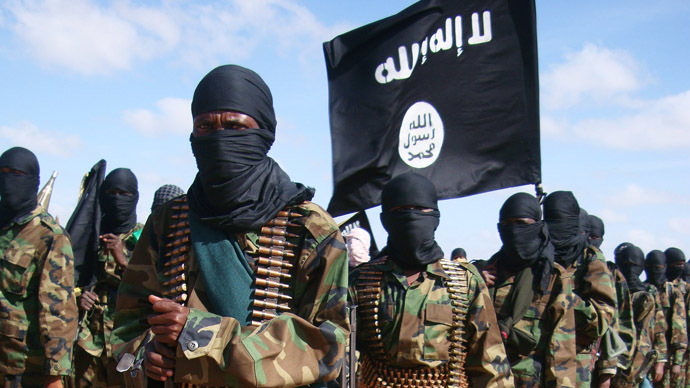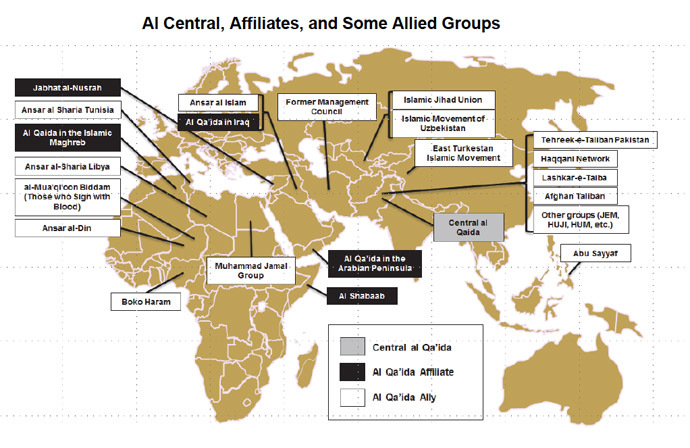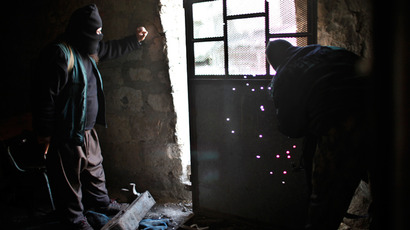‘Far from defeated’: Al-Qaeda is expanding and its ‘most significant foreign enemy’ is France

Al-Qaeda’s resilience, ideological strength and expansion in the midst of escalating sectarian struggle has increased the threat it poses - and it will take decades to win the ideological struggle against it, according to a new report.
“There has been a net expansion in the number and geographic
scope of al-Qaeda affiliates and allies over the past decade,
indicating that al-Qaeda and its brand are far from
defeated,” said author of the study and RAND corporation
analyst, Seth Jones.
Jones noted that what was once a highly organized group with a
strong base in Afghanistan has now reaped affiliates, allied
groups, and inspired networks of groups harboring a “hatred of
the West” and its allied regimes across the Middle East.
Tamerlan Tsarnaev, the suspected ringleader of the 2013 Boston
Marathon bombings, was given as an example of an
“inspired” individual who was not a member of al-Qaeda.
The core group itself has seen a general ascendance in the Middle
East and North Africa (MENA), for which a number of possible
reasons were given. Four separate subsectors or groups of the
militant block were identified: Central al-Qaeda, al-Qaeda
allies, al-Qaeda affiliates, and al-Qaeda ideological
sympathizers.

The Arab uprisings, which have “weakened regimes” in the
region, were given as a primary cause for al-Qaeda’s spread.
According to the report, the uprisings created an “opportunity”
for al-Qaeda affiliates and allies to consolidate a footing in
the regions.
Increasing sectarian struggles in the same areas means that
resources available to Sunni Islamic militant groups have also
grown, allowing weaponry to spread and be more accessible to
militants. Meanwhile, the movement has become “more diffuse
and decentralized” as a result of the expansion, Jones stated
in a testimony before the House Foreign Affairs Committee last
week.
Al-Qaeda members “largely run their operations autonomously,
though they still communicate with core leadership in Pakistan
and may seek strategic advice.”
Because of this diffusion and lack of solid organizational
structure to the militant movement, the study found that despite
an increasing availability of weapons, the group as a unit is
becoming less of a threat to the US. However, ideologically, it
is still growing stronger.
“The growth in social media and the terrorist use of chat
rooms, Facebook, Twitter, YouTube, and other sites has
facilitated radicalization inside the United States,” the
study says, outlining how the increased dissemination of
‘propaganda’ information and instructions on how to create bombs
has played a key role.
Despite being less of a threat to the US on its home territory,
affiliates and allies of the group continue to threaten US and
foreign outposts overseas, such as those in Tunisia in 2012.
“Jabhat al-Nusrah’s access to foreign fighters, external
network in Europe and other areas, and bomb-making expertise
suggest that it may already have the capability to plan and
support attacks against the West,” wrote Jones, adding that
there seems to be a “growing contingent of foreign fighters –
perhaps several thousand – traveling to Syria to fight in the
war.”
Most pressing Al-Qaeda threats
Although posing a certain ideological threat to the US, it
materialized that the most pressing concerns of the group were
considerably more localized than any international ‘end-game,’
the report claimed.
“Most Al-Qaeda leaders are not interested in establishing a
global caliphate and do not seek to overthrow regimes in much of
the world,” Jones wrote, adding that “they tend to have
rather more parochial goals,” focusing predominantly on
countries or regions rather than a global jihad.
The study found that their primary international target was,
surprisingly, France. “France, rather than the United States,
is the most significant foreign enemy,” the report stated.
For al-Qaeda’s current leader, Ayman al-Zawahiri, both a “near
enemy” and a “far enemy” are identifiable. For
him, “the primary goal is broader: to overthrow regimes in key
Muslim countries,” while attacking far-off countries is seen
as a means to an end rather than an end in its own right.
However, the document goes on to advise the US on how to counter
any direct threats. It encourages the country to implement a
“light footprint strategy that focuses on covert intelligence,
law enforcement, and Special Operations Forces,” adding that
the US should withdraw Afghan forces and instead focus on
conducting low-intensity operations in the area as they do in
Colombia.
A double-pronged approach would be most effective, combining the
ground strategy with an undermining of al-Qaeda’s ideology, the
report said, adding that today the US plays no lead role in
attempting to do so.
“The struggle against the al-Qaeda movement will be long –
measured in decades, not months or years. Much like the Cold War,
it is also predominantly an ideological struggle,” Jones
concluded.














